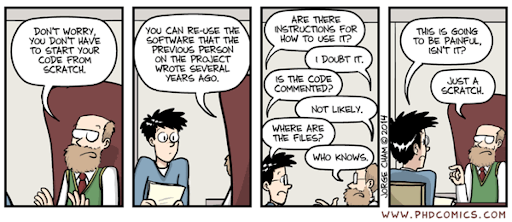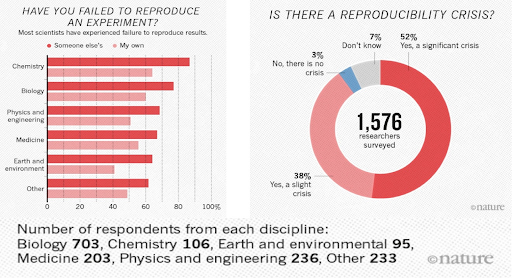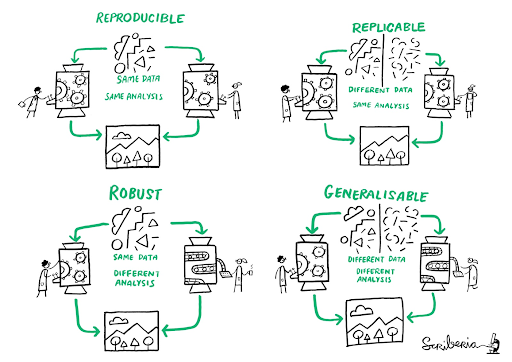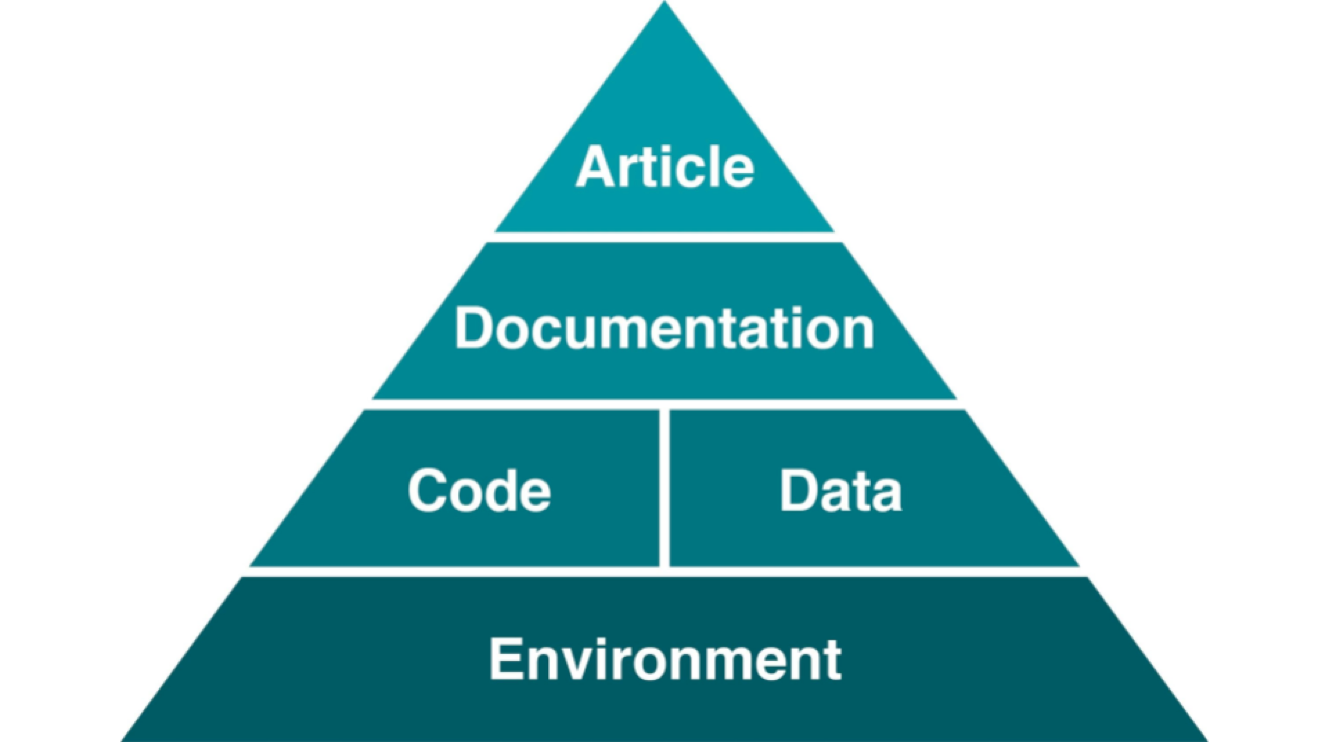Why R Markdown?
Overview
Teaching: 15 min
Exercises: 5 minQuestions
What is reproducible research?
How can R Markdown help research to be more reproducible?
What are the benefits of using R Markdown?
Objectives
Understand what scientific reproducibility entails.
Identify the benefits of using R Markdown to create research reports.
Understand how R Markdown is a useful tool in Open Science approaches.
Learn how R Markdown can help one’s research.
Warm-up
Let’s get into breakout rooms. What is reproducibility for you? Have you ever experienced issues to reproduce someone else’s study or even your own research?
The importance of Reproducibility in Research

Discussion: A scary anecdote
- A group of researchers obtain great results and submit their work to a high-profile journal.
- Reviewers ask for new figures and additional analysis.
- The researchers start working on revisions and generate modified figures, but find inconsistencies with old figures.
- The researchers can’t find some of the data they used to generate the original results, and can’t figure out which parameters they used when running their analyses.
- The manuscript is still languishing in the drawer…
According to the U.S. National Science Foundation (NSF) subcommittee on replicability in science:
Science should routinely evaluate the reproducibility of findings that enjoy a prominent role in the published literature. To make reproduction possible, efficient, and informative, researchers should sufficiently document the details of the procedures used to collect data, to convert observations into analyzable data, and to analyze data.
Reproducibility refers to the ability of a researcher to duplicate the results of a prior study using the same materials as were used by the original investigator. That is, a second researcher might use the same raw data to build the same analysis files and implement the same statistical analysis in an attempt to yield the same results. Reproducibility is a minimum necessary condition for a finding to be considered rigorous, believable and informative.
Why all the talk about reproducible research?
A 2016 survey in Nature revealed that irreproducible experiments are a problem across all domains of science:

Factors behind irreproducible research

- Not enough documentation on how experiment is conducted and data is generated
- Data used to generate original results unavailable
- Software used to generate original results unavailable
- Difficult to recreate software environment (libraries, versions) used to generate original results
- Difficult to rerun the computational steps
Reproducible, replicable, robust, generalizable
While reproducibility is the minimum requirement and can be solved with “good enough” computational practices, replicability/robustness/generalizability of scientific findings are an even greater concern involving research misconduct, questionable research practices (p-hacking, HARKing, cherry-picking), sloppy methods, and other conscious and unconscious biases.

If contributing to science and other researchers seems not to be compelling enough, here are 5 selfish reasons to work reproducibly (Markowetz, 2015)
- Helps to avoid data loss and disaster
- Makes it easier to write papers
- Helps reviewers see it your way
- Enables continuity of your work
- Helps to build your reputation
When do you need to worry about reproducibility?
Let’s assume that I have convinced you that reproducibility and transparency are in your own best interest. Then what is the best time to worry about it?
Throughout the whole research life cycle! Before you start the project because you might have to learn tools like R or Git. While you do the analysis because if you wait too long you might lose a lot of time trying to remember what you did two months ago. When you write the paper because you want your numbers, tables, and figures to be up-to-date. When you co-author a paper, because you want to make sure that the analyses presented in a paper with your name on are sound. When you review a paper, because you can’t judge the results if you don’t know how the authors got there.
Levels of Reproducibility

A published article is like the top of a pyramid, meaning that a reproducible paper/report rests on multiple levels that each contributes to its reproducibility.
What is R Markdown and how it connects to reproducible research?
R Markdown is a variant of Markdown, a system for writing simple, readable text that is easily converted to html which allows you to write using an easy-to-read, easy-to-write plain text format.
R Markdown belongs to the field of literate programming which is about weaving text and source code into a single document to make it easy to create reproducible web-based reports. Markdown is a simple formatting syntax for authoring HTML, PDF, and MS Word documents and much, much more. R Markdown provides the flexibility of Markdown with the implementation of R input and output. For more details on using R Markdown check http://rmarkdown.rstudio.com.
The idea of literate programming shines some light on this dark area of science. This is an idea from Donald Knuth where you combine your text with your code output to create a document. This is a blend of your literature (text), and your programming (code), to create something that you can read from top to bottom. Imagine your paper - the introduction, methods, results, discussion, and conclusion, and all the bits of code that make each section. With R Markdown, you can see all the pieces of your data analysis altogether.
You can include both text and code to execute. It is a convenient tool for reproducible and dynamic reports with R! With R Markdown, you are able to:
- Keep an eye on text (the paper) AND the source code. These computational steps are essential to ensure computational reproducibility.
- Conduct the entire analysis pipeline in an R Markdown document: data (pre-)processing, analysis, outputs, visualization.
- Apply a formatting syntax that is part of the R ecosystem and supports LaTeX.
- Combine text written in Markdown and source code written in R (and other languages).
- Easily share R Markdown documents with colleagues, as supplemental material, or as the paper under review. Thanks to the package knitr, others can execute the document with a single click and receive, for example, HTML or PDF renderings.
- Get figures automatically updated if you change the underlying parameters in the code. The error-prone task of exporting figures and uploading the right figure version to another platform is thus not needed anymore.
- Since Markdown is a text-based format, you can also use versioning control with Git.
- If you do not make any changes to the document after creating the output document, you can be sure that the paper was executable at least at the time of submission.
- Refer to the corresponding code lines in the methodology section making it unnecessary to use pseudocode, high-level textual descriptions, or just too many words to describe the computational analysis.
- Use packages such as rticles to use templates from publishers and create submission-ready documents.
Some Real-world Applications
Finally, three real-world examples that motivated the authors of this lesson to value and use R Markdown:
-
In the early days of the COVID-19 pandemic ecologist Chris Lortie quickly put together a simple but compelling COVID trends page. The ease with which he created his plots is a testament to the power of R as a data analysis environment, but the ease with which he was able to publish a page on the web is a testament to R Markdown and Github as a publishing environment. Notice that he did not have to: create plots in a tool and then export the plots as images; write any HTML; embed plot images in HTML; or create a site under Wordpress or other web hosting service. Instead, he directly published his R code as he wrote it, and using Github, made it appear on the web with a button click.
-
One of us wanted to create a short document that included some math formulas. The LaTeX document preparation can be used for this, but it is difficult to use and is overkill for just a few formulas in otherwise plain text. R Markdown lets you use just the best part of LaTeX—math formatting—while letting you write your text in a user-friendly way.
-
In this lesson we will be constructing a scientific paper that is based on an actual Nature publication and attendant survey and data. In trying to recreate the plots the original authors created, we found it difficult and time-consuming to figure out exactly how the authors created their plots. Out of the many columns in their data, many with similar-sounding names, which did they use? How did they handle missing data? Exactly what operations did they perform to compute aggregate values? How much easier it would have been if they had published the code they used along with their paper. R Markdown allows you to do this.
Our goal is that by the end of this workshop you will be able to create a reproducible report applying R Markdown and Knitr to publish a paper such as this example. This template is used exclusively for instruction purposes and is based on short and adapted version of the following academic paper:
Knudtson, K. L., Carnahan, R. H., Hegstad-Davies, R. L., Fisher, N. C., Hicks, B., Lopez, P. A., ... & Sol-Church, K. (2019). Survey on scientific shared resource rigor and reproducibility. Journal of biomolecular techniques: JBT, 30(3), 36. doi: doi: 10.7171/jbt.19-3003-001
Key Points
Reproducible research is key for scientific advancement.
R Markdown can help you to organize, have better control over and produce reproducible research.